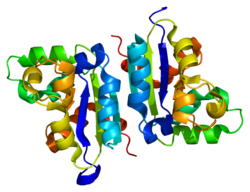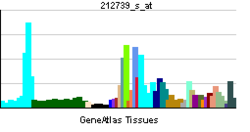- NME4
-
Non-metastatic cells 4, protein expressed in, also known as NME4, is a protein which in humans is encoded by the NME4 gene.[1][2]
Function
The nucleoside diphosphate (NDP) kinases (EC 2.7.4.6) are ubiquitous enzymes that catalyze transfer of gamma-phosphates, via a phosphohistidine intermediate, between nucleoside and dioxynucleoside tri- and diphosphates. The enzymes are products of the nm23 gene family, which includes NME4. The first nm23 gene, nm23-H1 (NME1), was isolated based on its reduced expression in a highly metastatic murine melanoma cell line and was proposed to be a metastasis suppressing gene. The human equivalent was obtained by cDNA library screening using the murine gene as a probe and found to be homologous to the Drosophila awd gene. A second human gene, nm23-H2 (NME2), encoding a protein 88% identical to nm23-H1, was subsequently isolated. Both genes were localized on 17q21.3 and their gene products were formerly identified as the A and B subunits of NDP kinases. In mammals, functional NDP kinases are heterohexamers of the A and B monomers, which can combine at variable ratios to form different types of hybrids.[2] These enzymes are highly expressed in tumors as compared with normal tissues. In some cell lines and in certain solid tumors, decreased expression of NME1 is associated with increased metastatic potential; moreover, when transfected into very aggressive cell lines, such as human breast carcinoma, NME1 decreased the metastatic potential. A third human gene, DR-nm23 (NME3), was identified and found to share high sequence similarity with the NME1 and NME2 genes. It is highly expressed in blast crisis transition of chronic myeloid leukemia. When overexpressed by transfection, NME3 suppressed granulocyte differentiation and induced apoptosis of myeloid precursor cells.[1]
References
- ^ a b "Entrez Gene: NME4 non-metastatic cells 4, protein expressed in". http://www.ncbi.nlm.nih.gov/sites/entrez?Db=gene&Cmd=ShowDetailView&TermToSearch=4833.
- ^ a b Milon L, Rousseau-Merck MF, Munier A, Erent M, Lascu I, Capeau J, Lacombe ML (April 1997). "nm23-H4, a new member of the family of human nm23/nucleoside diphosphate kinase genes localised on chromosome 16p13". Hum. Genet. 99 (4): 550–7. doi:10.1007/s004390050405. PMID 9099850.
Further reading
- Boissan M, Dabernat S, Peuchant E, Schlattner U, Lascu I, Lacombe ML (September 2009). "The mammalian Nm23/NDPK family: from metastasis control to cilia movement". Mol. Cell. Biochem. 329 (1–2): 51–62. doi:10.1007/s11010-009-0120-7. PMID 19387795.
- Milon L, Meyer P, Chiadmi M, et al. (2000). "The human nm23-H4 gene product is a mitochondrial nucleoside diphosphate kinase". J. Biol. Chem. 275 (19): 14264–72. doi:10.1074/jbc.275.19.14264. PMID 10799505.
- Daniels RJ, Peden JF, Lloyd C, et al. (2001). "Sequence, structure and pathology of the fully annotated terminal 2 Mb of the short arm of human chromosome 16". Hum. Mol. Genet. 10 (4): 339–52. doi:10.1093/hmg/10.4.339. PMID 11157797.
- Kowluru A, Tannous M, Chen HQ (2002). "Localization and characterization of the mitochondrial isoform of the nucleoside diphosphate kinase in the pancreatic beta cell: evidence for its complexation with mitochondrial succinyl-CoA synthetase". Arch. Biochem. Biophys. 398 (2): 160–9. doi:10.1006/abbi.2001.2710. PMID 11831846.
- Strausberg RL, Feingold EA, Grouse LH, et al. (2003). "Generation and initial analysis of more than 15,000 full-length human and mouse cDNA sequences". Proc. Natl. Acad. Sci. U.S.A. 99 (26): 16899–903. doi:10.1073/pnas.242603899. PMC 139241. PMID 12477932. http://www.pubmedcentral.nih.gov/articlerender.fcgi?tool=pmcentrez&artid=139241.
- Ota T, Suzuki Y, Nishikawa T, et al. (2004). "Complete sequencing and characterization of 21,243 full-length human cDNAs". Nat. Genet. 36 (1): 40–5. doi:10.1038/ng1285. PMID 14702039.
- Gerhard DS, Wagner L, Feingold EA, et al. (2004). "The Status, Quality, and Expansion of the NIH Full-Length cDNA Project: The Mammalian Gene Collection (MGC)". Genome Res. 14 (10B): 2121–7. doi:10.1101/gr.2596504. PMC 528928. PMID 15489334. http://www.pubmedcentral.nih.gov/articlerender.fcgi?tool=pmcentrez&artid=528928.
- Martin J, Han C, Gordon LA, et al. (2005). "The sequence and analysis of duplication-rich human chromosome 16". Nature 432 (7020): 988–94. doi:10.1038/nature03187. PMID 15616553.
- Rual JF, Venkatesan K, Hao T, et al. (2005). "Towards a proteome-scale map of the human protein-protein interaction network". Nature 437 (7062): 1173–8. doi:10.1038/nature04209. PMID 16189514.
PDB gallery Categories:- Human proteins
- Chromosome 16 gene stubs
Wikimedia Foundation. 2010.



